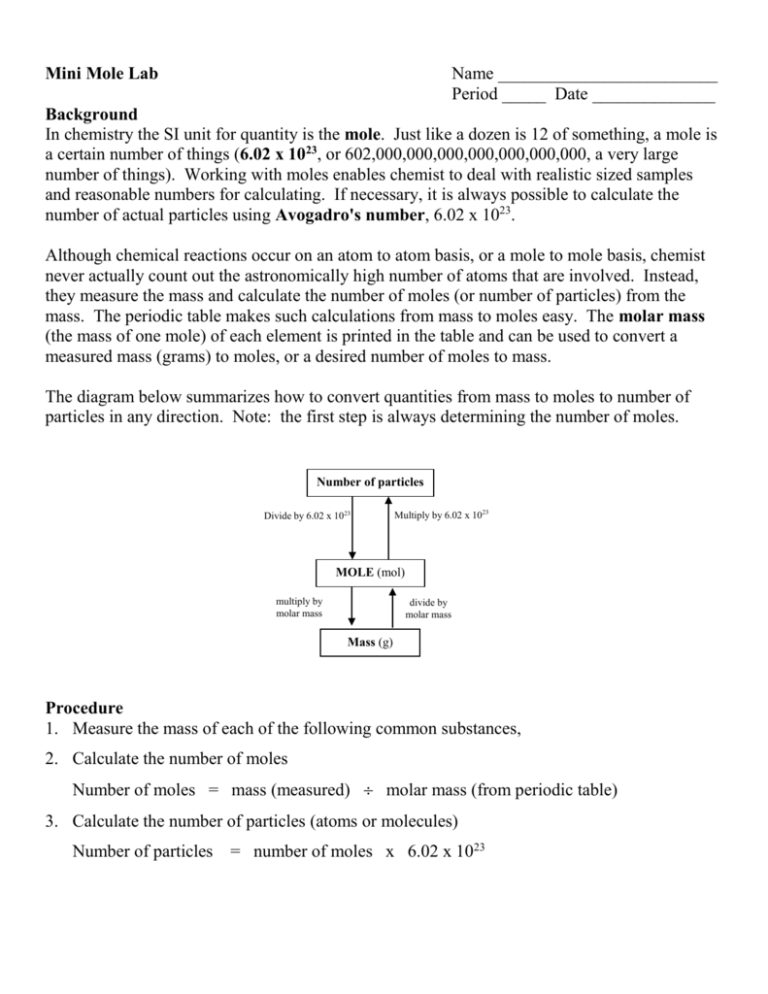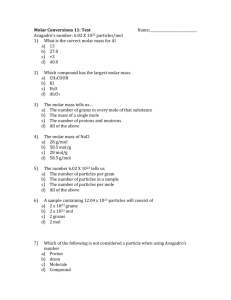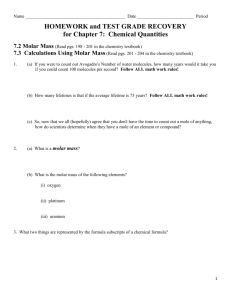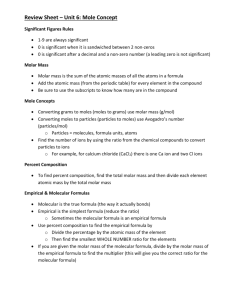Mini Mole Lab
advertisement

Mini Mole Lab Name _________________________ Period _____ Date ______________ Background In chemistry the SI unit for quantity is the mole. Just like a dozen is 12 of something, a mole is a certain number of things (6.02 x 1023, or 602,000,000,000,000,000,000,000, a very large number of things). Working with moles enables chemist to deal with realistic sized samples and reasonable numbers for calculating. If necessary, it is always possible to calculate the number of actual particles using Avogadro's number, 6.02 x 1023. Although chemical reactions occur on an atom to atom basis, or a mole to mole basis, chemist never actually count out the astronomically high number of atoms that are involved. Instead, they measure the mass and calculate the number of moles (or number of particles) from the mass. The periodic table makes such calculations from mass to moles easy. The molar mass (the mass of one mole) of each element is printed in the table and can be used to convert a measured mass (grams) to moles, or a desired number of moles to mass. The diagram below summarizes how to convert quantities from mass to moles to number of particles in any direction. Note: the first step is always determining the number of moles. Number of particles Divide by 6.02 x 1023 Multiply by 6.02 x 1023 MOLE (mol) multiply by molar mass divide by molar mass Mass (g) Procedure 1. Measure the mass of each of the following common substances, 2. Calculate the number of moles Number of moles = mass (measured) molar mass (from periodic table) 3. Calculate the number of particles (atoms or molecules) Number of particles = number of moles x 6.02 x 1023 (To perform this operation with a simple calculator, just multiply the number of moles by 6.02, then tack on the "x 1023" to the product. Example: 3 moles is (3)(6.02 x 1023) = 18.06 x 1023 particles.) Before you can do your calculating, you need the molar mass of the substances. Use the periodic table to find or calculate them. To calculate the molar mass of compounds add up the molar masses of the component atoms in the proportions indicated by the chemical formulas. Molar mass of C: _______ g/mol Molar mass of C12H22O11: _______ g/mol Molar mass of H: _______ g/mol Molar mass of C25H52: _______ g/mol Molar mass of O: _______ g/mol Molar mass of C9H8O4 _______ g/mol Data and Results Mass of charcoal briquette (C): _______________ g Molar mass of carbon: _______________ g/mol (see above) Calculated number of moles _______________ mol Calculated number of atoms _______________ atoms ------------------------------------------------------------------------------------------------------------Mass of sugar cube (C12H22O11): _______________ g Molar mass of C12H22O11: _______________ g/mol Calculated number of moles _______________ mol Calculated number of molecules _______________ molecules ------------------------------------------------------------------------------------------------------------Mass of candle (C25H52): _______________ g Molar mass of C25H52: _______________ g/mol Calculated number of moles _______________ mol Calculated number of molecules _______________ molecules ------------------------------------------------------------------------------------------------------------Mass of aspirin (C9H8O4): _______________ g Molar mass of C9H8O4: _______________ g/mol Calculated number of moles _______________ mol Calculated number of molecules _______________ molecules







